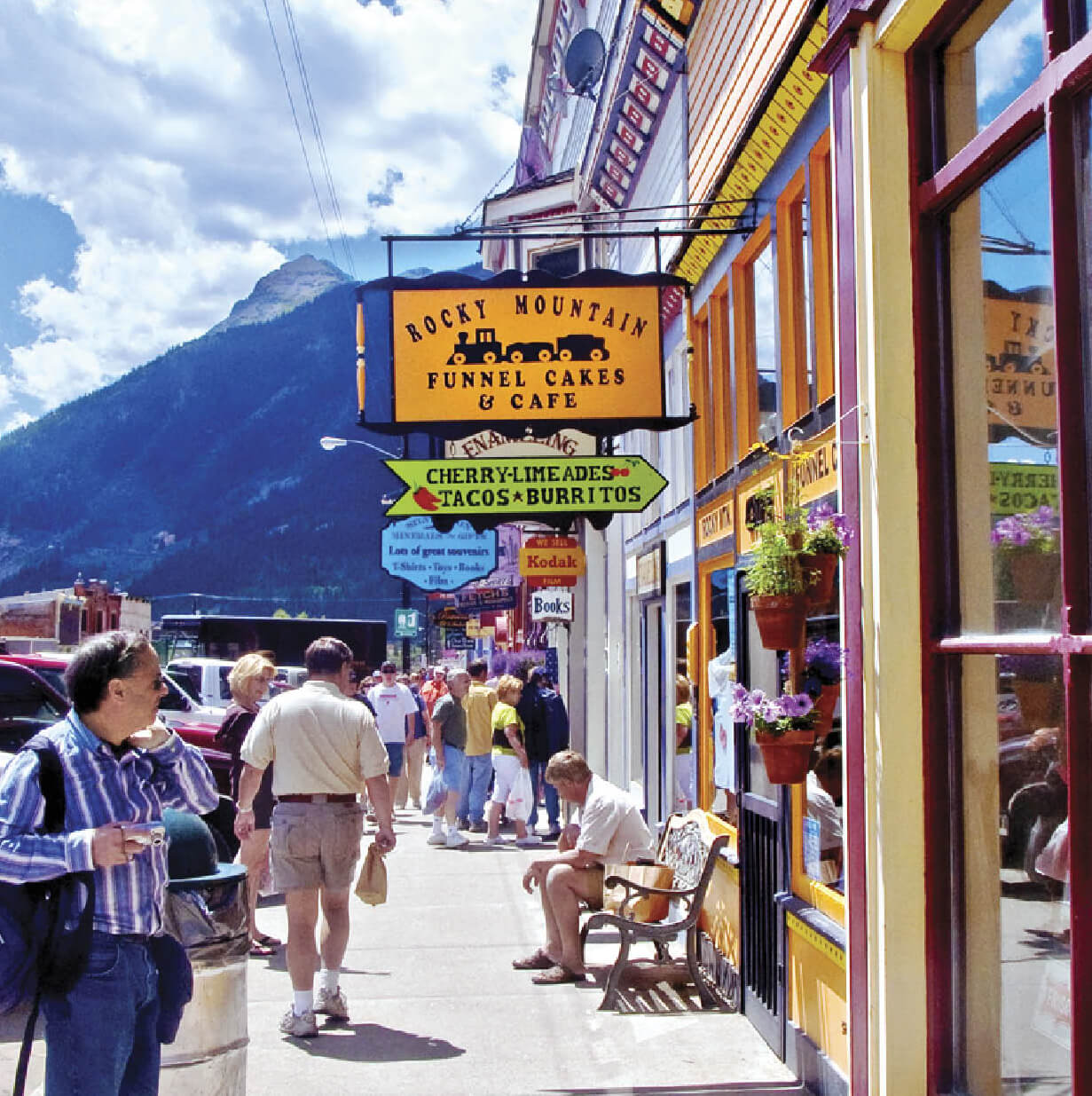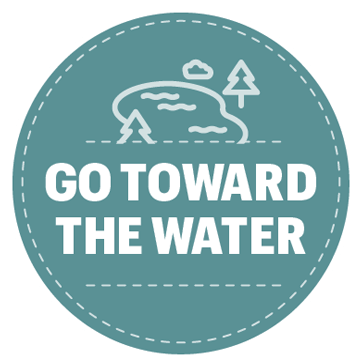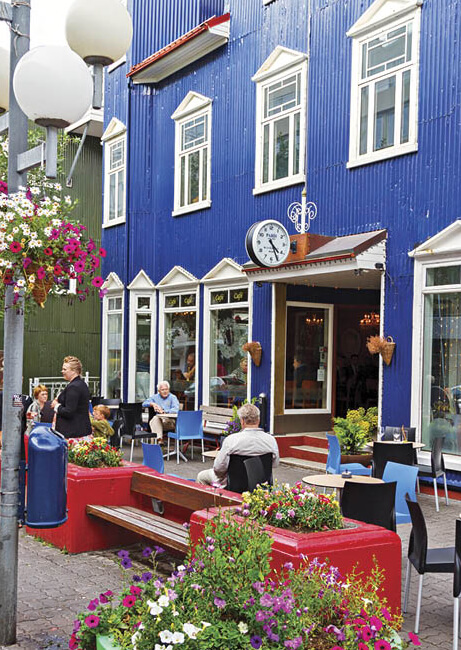Feature STORY
Out in the Cold
Feeling the heat? Take a ‘coolcation’
By Amy Alipio

Moraine Lake in Alberta, Canada
SUMMER VACATIONS are hot—literally, and not necessarily in a good way. Last summer was the warmest on record, so heading to Orlando or Las Vegas might not be appealing to older people, who can be particularly susceptible to the ill effects of heat.
Enter the “coolcation.”
Instead of hitting a hot spot, travel to a place where you can beat the heat. “We recognize that extreme weather events are an increasing concern for American travelers,” says Gloria Loree, senior vice president for marketing strategy at Destination Canada.
But heading to Canada—or Alaska—isn’t your only option to enjoy mild summer weather. There are plenty of cool destinations to be found in the contiguous United States too, especially in the mountains or near major bodies of water. Check out these chill spots.

Make Some Changes in Latitude
Banff, Alberta
Summer high temperatures: mid-60s
BANFF has all the ingredients for an ideal Canadian Rocky Mountains experience: glacial lakes that glow turquoise, snow-etched peaks, exhilarating hikes—and comfortable temperatures. “International tourists come through, all wearing their jackets in summer,” says local Jason Carter, 45. “And it’s like, ‘What is going on? It’s not that cold here, is it?’ ”
Carter is an Indigenous visual artist from the Little Red River Cree Nation who co-owns Carter-Ryan Gallery in the town of Banff. Visitors can also experience the summertime Art in Nature Trail along the Bow River, which is lined with more than 65 displays by regional artists.
Travelers to Banff—Canada’s first national park—can also pick up a copy of Banff’s Indigenous Experiences Map, leading to 15 historic sites, museums and natural spaces.

Denali National Park and Preserve, Alaska
Summer high temperatures: low 60s
THIS 6-million-acre wilderness draws a steady stream of coolcationers who gaze at the majestic sweep of the Alaska Range, including North America’s highest mountain peak at 20,310 feet. Denali is “often deemed the ‘crown jewel’ of Alaska’s public lands,” says park guide Damian Popovic.
A park bus serves stops where you can hop off and go for a leisurely scenic hike, such as the 1.7-mile Savage River Loop Trail. Or visit the sled dog kennels to learn how these canine rangers provide vital transportation on those subzero winter days when motors won’t start.

St. John’s, Newfoundland and Labrador
Summer high temperatures: mid-60s
NOTHING announces summer in St. John’s like a massive iceberg arriving just off the coast. These frosty floaters—which range in size from itty-bitty to cruise-ship—drift down from Greenland and Arctic Canada. So many of them make the journey that the eastern coast of the Canadian province of Newfoundland and Labrador has been dubbed Iceberg Alley.
Take a boat tour out from St. John’s harbor to spot the unique trifecta of icebergs, whales and puffins, all in one day. Back on land, you can sample beer made with iceberg water at Quidi Vidi Brewery Co. in St. John’s.
“May through early July is your best time for icebergs,” says Richard Arnold, president of Halifax-based Atlantic Tours, which offers itineraries for Atlantic Canada’s four provinces.
As thrilling as Newfoundland’s marine wonders are, Arnold says his tour clients aren’t just there for the cool climes; they’re also there for the friendly locals. “One of the things that they’re going to hear about is something called a Newfoundland Screech-In, to make you an honorary Newfoundlander,” he says. This informal welcoming ceremony may happen randomly on a boat tour or in a pub or someone’s home, and it might involve making a pledge, kissing a codfish and drinking some Newfoundland Screech rum. “To see the looks on people’s faces, and their smiles, is pretty spectacular.”

Make a Run for the Mountains

Million Dollar Highway
Southwestern Colorado
Summer high temperatures: low 70s
PART of the appeal of Silverton is the journey. Located in southwest Colorado, the historic mining town is at one end of the so-called Million Dollar Highway, a gorgeous 25-mile stretch of U.S. Route 550 that snakes through the San Juan Mountains from Ouray. “Right around the Fourth of July, the wildflowers are absolutely amazing. Columbines are the state flower, and they’re everywhere, and there are waterfalls, and it’s just amazing,” says Frada Boxer, 76. She and her husband, George Starkschall, 78, split their time between Texas and Colorado.

“It’s also an uncomfortable ride if you’re scared of heights, because it’s a road without any guardrails,” says Starkschall. But it’s worth it, he says, because “the scenery is just unbelievable. You have a couple of red mountains there that are red because of the iron ore, and you can see for long distances.”

Or you can get there by steam train. The iconic Durango & Silverton Narrow Gauge Railroad offers 3.5-hour rides from the historic railroad town of Durango. The temperature gradually drops as the train ascends to Silverton. With the Animas River meandering below and forested peaks all around, keep an eye out for elk, black bear and other mountain wildlife. Once you’re in Silverton (population: about 600), there’s mining heritage and a charming Old West main street to explore.

Chill by a Lake ... or a River

Kennebec River
Maine
Summer high temperatures: 70s
MAINE’S wild Atlantic coast is a popular destination. But for an equally cool experience, head to the lakes and rivers. Sebago Lake’s sandy beaches and tranquil waters are about an hour’s drive from Portland. The deepest lake in Maine has an average water temperature of 78 degrees in summer. It’s easy to cool off by going for a swim in crystalline waters or sitting on the shore with a good book—perhaps John McPhee’s The Survival of the Bark Canoe, the account of his trip down Maine’s Allagash River.
North of Sebago, Moosehead Lake is Maine’s largest. Sign up for a moose safari to see the official state animal.
The dam-controlled Kennebec River, which is fed from Moosehead Lake, flows south and is famed for its whitewater rafting. “We’re able to go rafting from May to October,” says Russell Walters of Northern Outdoors lodge in the Forks, “whereas in other places in the country, by the middle of summer, it’s all done.” Walters says he’s had people on trips who first rafted there 30 years ago. “Now we see them coming up with their kids and grandkids.”

Mackinac Island
Mackinac Island, Michigan
Summer high temperatures: mid-70s
A SUMMER trip on Mackinac Island doesn’t involve the roar of car engines. Instead, you’ll hear the clip-clop of hooves and the whir of bicycle wheels. Mackinac is car-free. Even the taxis are horse-drawn carriages. “From the moment you step off the ferry, it’s a dial down from everyday life,” says visitor Diane Densmore, 63, of Davison, Michigan. “And there is always a gentle lake breeze.”
Located on Lake Huron, between Michigan’s Upper and Lower peninsulas, Mackinac (pronounced MACK-in-awe) has long been a sacred place for Anishinaabek peoples. It served as a military outpost and a hub of the Great Lakes fur trade. And it has been a resort destination for Midwesterners escaping the summer heat since the 19th century.
“The quintessential thing to do is to bike or take a carriage around the island. It’s also really fun to bike or taxi at night with lights, especially when you hear taps sounded at Fort Mackinac or a foghorn in the distance,” Densmore says.
One more reason for a trip: “No visit is complete without at least a little piece of fudge,” Densmore says.

San Francisco
Summer high temperatures: low 70s
AN IMPORTANT tip for a summer trip to San Francisco: Pack warm clothing. “There are always stories in the San Francisco Chronicle every summer about some high school kid who is making money for his college tuition by selling sweatshirts to unaware tourists,” says area resident Richard Weiss, 80.
San Francisco’s variable weather conditions—including the famous morning fog, nicknamed Karl—mean that you can be on a chilly, windy stroll along Ocean Beach in the Sunset District, then in 30 minutes strip off your jacket while exploring the Mission District’s colorful murals. Adventurous travelers can trek the 17-mile Crosstown Trail, which traverses the city from southeast to northwest.
Amy Alipio is a former managing editor of National Geographic Travel.
COOLCATIONS FARTHER AFIELD
Where to escape the heat as you experience other cultures

Bodø, Norway
This colorful city inside the Arctic Circle boasts festivals, art exhibitions and concerts. And you’ll enjoy round-the-clock sunlight throughout June and in early July. Touring Bodø’s museums, design-forward boutiques and restaurants can fill such an extended summer day.

Akureyri, Iceland
Many tourists may stick to the capital city of Reykjavik, but this walkable town on the northern coast of the island features an art museum and a botanic garden in town, with nearby hiking trails (see the waterfalls) and whale-watching tours.

Tohoku region, Japan
In the cool mountainous Japanese countryside, enjoy scenic hikes, peaceful temples and cultural attractions, including Aizuwakamatsu, “the land of the samurai.”

San Carlos de Bariloche, Argentina
When it’s summer in the U.S., it’s winter here. The scenery is stunning, with the snow-capped Andes Mountains near the shores of dazzling blue Lake Nahuel Huapi. —Bill Fink
From top: Alamy; Shutterstock; Greg Locke/Reuters/Redux; Getty Images; TOLA/eStock Photo; Getty Images; Courtesy Northern Outdoors; Getty Images; Claudia Uripos/eStock Photo; Mariner/Courtesy Visit Norway; Alamy; Shutterstock (2)